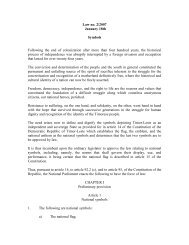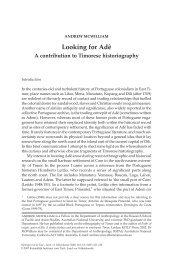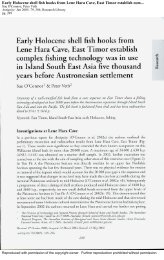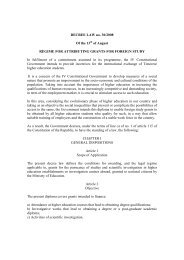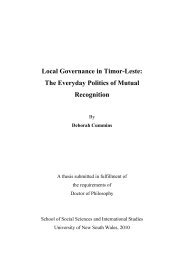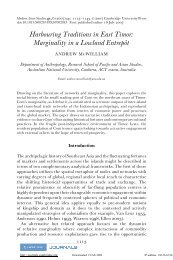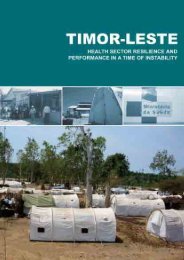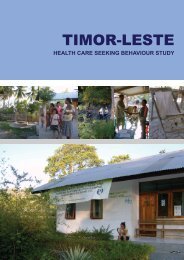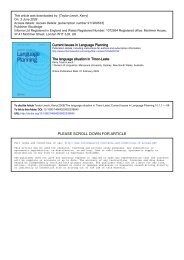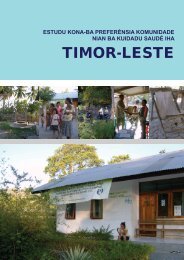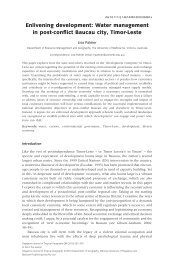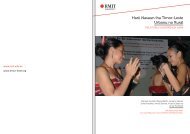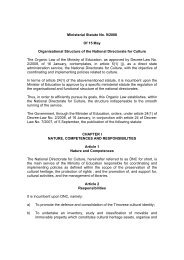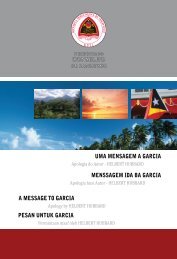The Naueti relationship terminology - Secretaria de Estado da Arte e ...
The Naueti relationship terminology - Secretaria de Estado da Arte e ...
The Naueti relationship terminology - Secretaria de Estado da Arte e ...
You also want an ePaper? Increase the reach of your titles
YUMPU automatically turns print PDFs into web optimized ePapers that Google loves.
244<br />
David Hicks<br />
alliance, progressing through several intermediate stages to the most complex,<br />
non-lineal or cognatic. Although there are certain nuanced differences, the<br />
polar representatives of his construct are congruent with Clau<strong>de</strong> Lévi-Strauss’s<br />
‘elementary structures’ and ‘complex structures’ (1949), and my mo<strong>de</strong>l of eastern<br />
Timorese terminological evolution adopted Needham’s argument regarding<br />
the direction of the terminological progression.<br />
Logically, of course, the opposite directionality would be possible, and<br />
such an alternative mo<strong>de</strong>l has been proposed by Jean-François Guermonprez<br />
(1998) and found consistent with the ethnography of a central Flores population,<br />
the Ngadha (Sme<strong>da</strong>l 2002). Guermonprez’s analysis is based upon the<br />
analysis of the categories of the three medial genealogical levels (first ascending,<br />
ego’s level, and first <strong>de</strong>scending) employed in the <strong>relationship</strong> terminologies<br />
of twenty-one societies in the South Moluccas. In his mo<strong>de</strong>l a non-lineal<br />
<strong>terminology</strong> evolves through intermediary stages in the direction of asymmetry,<br />
and Olaf H. Sme<strong>da</strong>l (2002) finds in the social facts of Ngadha ethnography<br />
<strong>da</strong>ta that lend empirical substance to Guermonprez’s theory. So pertinent are<br />
his <strong>da</strong>ta that they enable him to provi<strong>de</strong> an alternative force for the evolution<br />
of the terminologies of eastern Indonesia. He suggests that the<br />
geographically <strong>de</strong>limitable, disparate bri<strong>de</strong>wealth arrangements that the Ngadha<br />
evince may, over time, result in a realization that one’s interests are best served if<br />
those arrangements are complemented by either a full-fledged asymmetric, lineal<br />
<strong>terminology</strong> [...] or a dismantling of the bri<strong>de</strong>wealth institution altogether [...]<br />
(Sme<strong>da</strong>l 2002:519).<br />
Both directional mo<strong>de</strong>ls are admittedly speculative since the historical information<br />
necessary to verify their validity is lacking, but speculation of this sort<br />
nevertheless has a heuristic value in that it enables one to compare the characteristics<br />
of different <strong>relationship</strong> systems according to a distinct perspective<br />
which would otherwise be unavailable. And so, by way of ancillary intent, the<br />
present paper attempts to compare the structure of the <strong>Naueti</strong> <strong>terminology</strong><br />
with those of certain other terminologies in the region by using both diachronic<br />
mo<strong>de</strong>ls, that of Needham’s and that of Guermonprez’s.<br />
Ethnographic background<br />
<strong>The</strong> nation of East Timor is divi<strong>de</strong>d into thirteen administrative districts, each<br />
of which comprises a number of subdistricts. Subdistricts in East Timor are<br />
ma<strong>de</strong> up of indigenous socio-political conglomerations known as suku (or al<strong>de</strong>ia),<br />
which themselves are composed of hamlets. <strong>The</strong> focus of life for the 80%<br />
or so of the population who live outsi<strong>de</strong> the capital, is the suku, at which level



